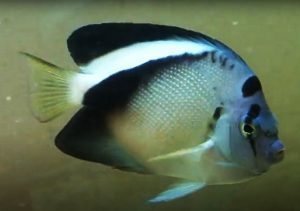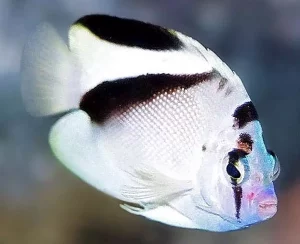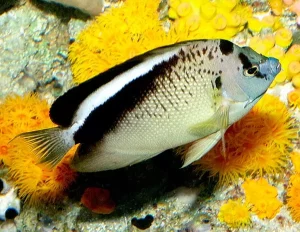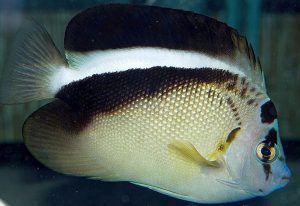The Griffis Angelfish (Apolemichthys griffisi) known to tropical fish keeping enthusiasts as Griffis’ angelfish is a unique species that was originally discovered in the middle of the North Pacific Ocean in the area of the Gilbert Islands south of the Marshall Islands, and about half way between Papua New Guinea and the Hawaiin Islands.
It’s range appears to extend to several areas of Micronesia, Indonesia, Papua New Guinea, and various locations of Oceania like the Caroline Islands, Solomon Islands, Nauru, and Kiribati, which seems to be the eastern limit for the species.
Griffis Angelfish are usually found living in the deeper waters of the steep outer reef slopes at depths around 130 to 295 feet where they have been observed feeding on sponges, sea squirts, and tunicates alone, in pairs, and very rarely in small groups with one male controlling a small territory and a harem.
Although Apolemichthys griffisi are unique and rare in the aquarium trade, they are occasionally available to tropical fish keeping enthusiasts.
Juvenile Griffis Angelfish have a white body with a single black stripe on the upper half of the fish. As they turn into adults, the colors on the upper half of the fish darken and a white stripe forms.
Adult Griffis Angelfish have a grayish to almost tan lower body color with a net like pattern of white spots and three bold black and white stripes along the upper half of the body. They have a wedge shaped black marking that travels through the eye, a black splotch on the forehead, and a bluish color towards the snout. Like all marine angelfish, they are hermaphroditic, with no visible distinguishing features between males from females.
The only other marine angelfish that has similar bold black and white patterning is the Bandit angelfish (Apolemichthys arcuatus) from Hawaii.
Griffis Angelfish adapt readily to an aquarium environment and are considered to be one of the least aggressive of the larger angelfish.
Although Apolemichthys griffisi may eat some species of hard and soft corals and are not considered to be reef safe, they do well in a large, coral rich tank reef tank of at least 125 gallon capacity with sessile inverts and plenty of mature live rock to graze on and configured into caves, overhangs, nooks, and crevices for them to hide among.
Of all the large angels, Griffis Angelfish are considered to be one of the safer choices for reef aquariums and has been proven not to pick on sessile invertebrates.
Griffis Angelfish are a great addition to large reef tanks but because they are known to nip at large polyp stony corals, some soft corals, and tridacnid clam mantles; most tropical fish keeping enthusiasts find that they are best housed in a fish only environment. Because they are not a fast swimming species, they should be provided with lots of free swimming space.
Griffis Angelfish prefer moderate tidal currents, so at least a couple of powerheads in their tank would be appreciated. Lighting
should be moderately strong to strong in at least one area of the tank to promote the growth of algae.
Griffis Angelfish have not been bred in an aquarium environment. Like all Pomacanthidae, the mating ritual occurs during the late evening hours when the predation of eggs is less likely. When the female is ready to lay her eggs, coupling occurs and the eggs are fertilized by the male in the water column. The eggs rise to the surface and drift with the currents without any additional care from the parents.
In their natural environment, Griffis Angelfish are omnivores that feed primarily on tunicates; sponges, ascidians, and betnthic algae. In an aquarium environment, they can be difficult to feed but their diet should include Spirulina, marine algae, a high quality angelfish preparation that includes sponges, mysis
or frozen shrimp, and other meaty items. Because they are grazers, feeding small portions 3 times a day is preferred to only one large daily feeding.
Because of the depths that they are collected and the locations in the Central Pacific Ocean where they are found, Griffis Angelfish (Apolemichthys griffisi) are truly a unique acquisition for any lucky tropical fish keeping enthusiast. They are only occasionally available from online importers at the following purchase sizes at prices that can put a dent into your pocketbook.
Size: 1.5 – 2.25 inches $974.99; 2.25 – 3.25 inches $1049.99; 3.25 – 4.25 inches $1087.99;
4.25 – 5.25 inches $1499.99; 5.25 – 6.25 inches $1499.99; 6.25 – 7.5 inches $1499.99
Minimum Tank Size: 125 gallons
Aquarium Type: Mature live rock or Reef
Care Level: Very Difficult
Temperament: Semi Aggressive
Aquarium Hardiness: Hardy once established
Water Conditions: 73.4 °F – 82.4 °F, dKH 8 to 12, pH 8.1 – 8.4, sg 1.020-1.025
Max. Size: 10″
Color Form: Black, White
Diet: Omnivore
Compatibility: Reef w/Caution
Origin: Central Pacific; Caroline Island, Indonesia, Kiribati, Line Islands, Marschall Islands, Micronesia, Nauru, Papua New Guinea, Philippines, Phoenix Islands, Solomon Islands, Sulawesi
Family: Pomacanthidae
Lifespan: 5 years
Aquarist Experience Level: Expert Only





